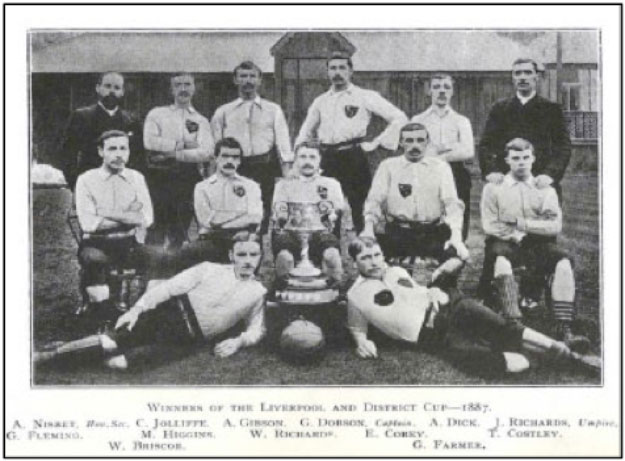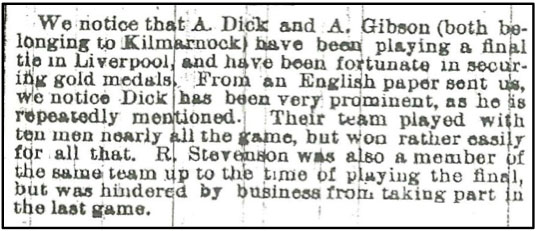
Although destined never to play a Football League match for the club, Andrew Gibson played a leading role in the years leading up to Everton becoming founder members of the new organisation. He had been at the club for two seasons when the above picture was taken and he had travelled a somewhat roundabout route to reach the town where he would spend the rest of his days.
Andrew Gibson was born on 31st January, 1864, at the number 3 house in the High Main Street of the Ayrshire market town of Dalmellington. His Father and Grandfather, both named Alexander, belonged to the accident order of Fleshers (qualified slaughter men) thus making the family prominent members of the local community.
The 1881 census lets us know that Andrew, now 17, had moved to the town of Kilmarnock which was expanding due to the fact that it is now the headquarters of Glasgow and South Western Railway Company. He was living with relatives at 22 West Shaw Street and working as an apprentice engine fitter. Gibson then came into contact with John Goodall and Alec Dick when he played football for Kilmarnock Athletic on their home ground at Holm Quarry. They were one of the leading teams in Ayrshire and their star players soon attracted the attention of the local agents who were authorised to act on behalf of the football clubs from the North West of England.
In the January of 1884, Great Lever Football Club signed four men, John Goodall amongst them, from Kilmarnock Athletic to play for them on the new ground they had recently developed at Woodside in Bolton. Pat Gallocher and Davie Waugh, two Scotsmen who had previously played football for Padiham, were also added to the squad. The new players had an immediate impact on the results of the Great Lever club and this encourages them to add three more new players, one of whom is Andrew Gibson from Kilmarnock Athletic. He made his debut on the 13th of December 1884 against a Preston North End side that had recently knocked Great Lever out of the FA Cup.
The occasion draws a tremendous crowd of spectators to the Deepdale ground who see the visitors take an early lead with a goal courtesy of a John Goodall. The game was then marred by an injury to the home skipper Jack Belger who had his leg broken when his attempted shot at goal was fiercely blocked by Andrew Gibson. The ten men of Preston, however, drew level in the second half goal as the game ended in 1-1 draw.
Andrew Gibson then took part in a plethora of games that had been arranged by the Great Lever committee to see them through the festive season. First to arrive were West Bromwich Albion who were beaten by 3 goals to 1 in front of 1,500 spectators. Third Lanark, Blackburn Olympic and Burnley were all beaten by the Woodside club who went on a winning streak that took them well in to the New Year. Nevertheless, Andrew Gibson soon lost favour with Great Lever selectors and was not seen in the clubs first X1 for the remainder of the season. They were, however, rich pickings for this new breed of professional footballer to be had in the Red Rose County and John Goodall, at the beginning of next season, moved to Preston North End while Andrew Gibson made a sudden appearance in the ranks of the Bootle club. He played his first game for them on the 3rd of October 1885.
The North Merseyside club had made a poor start to the new season losing 2-0 to Everton at Anfield and then being eliminated from the Lancashire knockout by the village side of Cherry Tree. Gibson made his debut in a local derby game against Stanley at Walton Stiles where he was opposed by both Alec Dick and Rob Stevenson who were his former team mates at Kilmarnock Athletic. Thrust in to the heart of the Bootle defence he helped his side to win the game by 4 goals to 2 and by the end of the month Andrew Gibson found himself facing Everton.
The two clubs had found themselves with a vacancy in their fixture list so the game was hastily arranged to played in a thunderstorm at Anfield in front of a crowd of 2,000 hardy souls who decided to brave the dreadful conditions. Gibson played in the Bootle half back line against a home side who began the game with the elements, and the pronounced slope, against them. Nonetheless they led 2-1 at the interval. Things looked anything but favourable for the visitors as the home side applied the pressure but they held firm against the persistent attacks by the Everton forwards. Bootle, to the delight of their followers, then claimed an honourable draw with an equalising goal that was scored five minutes from time and the game ended “all square”. Andrew Gibson, and his team mates, now looked forward to the return game on their home ground at Hawthorne Road. The occasion, once again, was influenced by the weather.
The Everton party arrived at Hawthorne Road to find the Bootle payers and officials hard at work removing the overnight snowfall that had put the game in jeopardy. They visitors then rolled up their sleeves and helped to make the pitch playable before the gates were thrown open and the crowd began to pour into the enclosure where a crowd of 4,000 saw Everton win 1-0.
The game had ended in disappointment for Andrew Gibson but his performance must have been “well noted” by the members of the Everton executive. He continued to perform well for the rest of the season and was present in the Bootle side when they faced Everton in the final of Liverpool & District FA knockout in 1886. The game took place on the home of the Stanley FC at Walton Stiles.
There are a few descriptions in the local newspapers of this location but it was almost certainly of a “most basic nature”. Nevertheless 8,000 people were reported to be inside the enclosure to see Everton score the only goal of the game and lift the trophy. It was to be the last time that Andrew Gibson wore the dark blue and white striped jersey of Bootle for during the months of summer he crossed over Breeze Hill and joined Everton at Anfield. The move however, disappointed a large number of Hawthorne Road faithful.
Everton had been anxious to sign a competent half back because Tommy Fayer was now absent from Liverpool, having signed on for a long sea voyage as a ships cook that would take him on a round trip to Australia. Andrew Gibson made his debut before an almost capacity crowd against Bolton Wanderers at Anfield where he lined up alongside his former team mate from Kilmarnock Athletic, Alec Dick, who had also joined Everton from Stanley. The visitors won the game by 3 goals to 1. As this was the only major game played in the area there were many supporters of Bootle reported to inside the Anfield enclosure and when they voiced some disapproving remarks in the direction of Andrew Gibson a local journalist decided to pen the following article…
The position of Tom Fayer was taken by — oh irony of fate — by the best hated man from the rival camp. Events move quickly in these fast times. It seems but yesterday when howls of execration greeted a certain stalwart as he dashed with all his might at the defenders of the Everton goal. He was now a Stiff-un, and something very more uncomplimentary, for he is now well worth so much a week. If Andy’s new friends have much to forget, his old ones have learnt a lesson. It is not too much to say that amongst the followers of Bootle, Gibson was the most popular of their players. His election as vice-captain is proved of this. No player either was ever profuse in his protestations of loyalty. Nobody will deny a professional player has the right to offer his services to the highest bidder, but people have the odd knack of remembering that there such old fashion virtues as gratitude, friendship and loyalty and such are usually considered a beyond expression the currant coin (Liverpool Courier.)

These comments prove that part-time professional football had now been established on Merseyside and that Andrew Gibson had been offered more money to transfer his services into an Everton club who appeared to have more wealth then that of Bootle. The incident must, however, have still been fresh in the minds of local football fans when Bootle drew Everton the local knockout because this well-documented occasion produced a crowd of people never before seen on Merseyside. Over 10,000 people packed the Hawthorne Road to see Everton win the game by 2 goals 0. Andrew Gibson, along with Dick and Fleming, were not yet eligible to play in the FA knockout so when Everton were paired with the Rangers club of Glasgow the executive decided to scratch from the tournament and the match went ahead as a friendly. The visitors won by 1 goal to 0. Everton then went on to win the Liverpool Senior Cup by beating Oakfield Rovers and this fact was recorded in a local newspaper report from Kilmarnock.
Andrew Gibson,who resigned for Everton then took part in a season that would see the structure of the club change forever. They now introduced another five Scottish players to their ranks but Gibson made the centre half position his own and took part in all four FA Cup ties that were required to eliminate Bolton Wanderers and was again in the side when they were eliminated by Preston North End. The FA then stepped in and declared six Everton players, Alec Dick amongst them, to be off “professional status” and suspended them from playing for the club until the situation was rectified. Andrew Gibson, however, escaped censure and disappeared beneath the radar where he waited until the dust had settled. He then reappeared at heart of the Everton defence but he now had stiff competition from both Richard and Robert Jones who were on trial at the club from Wrexham. Andrew Gibson played his last game, against Wolverhampton Wanderers, in May 1888 and had left the Everton club when they joined the Football League in the following September.
It is difficult to ascertain the reason why Gibson never played a Football League game for Everton but the main reason seems to be the signing of Jonny Holt from Bootle who took over his position at the heart of the defence. He nevertheless appeared, along with several of his former team mates, in the ranks of Everton Athletic and took part in several matches before retiring to private life sometime around 1890.
The 1891 census finds Andrew Gibson living with a widowed lady named Alice Lawless and her younger daughter Minnie at 53 Crete Street in Kirkdale. He listed his occupation as that of an engine fitter. On the 23rd of May, 1892, he married Wilhelmina Lawless at the church of St Mary, Walton on the Hill and the couple settled at Crete Street where their first child, Flora, was born one year later. The 1901 census finds the couple, who now have five children, still residing at this address. The family later moved to 74 Melbourne Street in Everton and the 1911 census lets us know that they now have 6 children. Andrew Gibson spent the rest of his days at this address and died there in December 1936.
